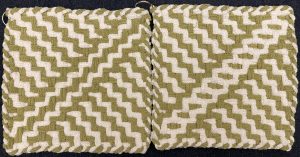The paired direction changes force a diagonal groove into the fabric, creating a natural grip for pan handles. Continue reading “Ziggity-Do-Dah”
Blog
Basketweave Coaster
A two-over/two-under tabby or basketweave wants to shrink, and will collapse in on itself once removed from the tension of the loom. You can capitalize on this to produce on the 18-peg loom a thick, absorbent, flexible yet flat fabric, very suitable for use as a coaster. Continue reading “Basketweave Coaster”
Haring To Go
Playful line crossings look very different on the reverse of this mostly tabby design. Continue reading “Haring To Go”
Herringbone
An elegant extension of zigzag twills. Continue reading “Herringbone”
Floating Diamond
Out of right angles, a diamond appears! The fabric distortions at the floats forcing the direction changes enhance the optical illusion by drawing your eye.
Continue reading “Floating Diamond”
Twisty Passages
Chartres Labyrinth Revisited
Twinkle Twinkle
The puffy fabric makes the stars twinklier. A spectacular effect worked with navy blue and silver. Continue reading “Twinkle Twinkle”
Rick Rack vs. Garden Path


Here are two 2/2 twill patterns demonstrating how a very small change in weaving order can have a dramatic design impact. Continue reading “Rick Rack vs. Garden Path”
Cross Breeze


A 2-2 twill with a row of over-3s where the lines change direction. (Originally published on Facebook as “Cross Purposes”.) Continue reading “Cross Breeze”









